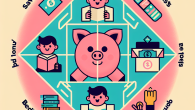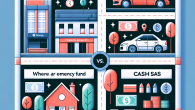
From Monzo to Plum: Ranking My Favourite UK Fintech Tools for Savings
The FIRE Movement: How to Achieve Financial Independence and Retire Early
If you’ve ever sat in a never-ending Zoom meeting, daydreaming about sipping margaritas on a beach at 10 a.m. on a Wednesday *without worrying about PTO*, then you’re going to love this topic. The FIRE movement — no, not actual flames — stands for “Financial Independence, Retire Early.” It’s a financial lifestyle that’s part rebellion, part spreadsheet, and 100% life-changing. Yes, you can design a life with more freedom and fewer emails. And girl, I am here for it.
Let me walk you through FIRE: what it is, how it works, the different versions of the movement, and — most importantly — how you can *actually* make it happen. Buckle up, because this strategy is not just for engineers in Silicon Valley or crypto bros in Bali. It can work for you too.
What is the FIRE Movement?
FIRE stands for Financial Independence, Retire Early. It’s a lifestyle and financial strategy where you live well below your means, invest aggressively, and save like your future depends on it (because, well, it does). The goal? To build enough passive income so you can cover your living expenses — and say “thank you, next” to traditional full-time work.
This movement originated with the 1992 book Your Money or Your Life by Vicki Robin and Joe Dominguez, and it’s gained traction in recent years because, let’s face it, job security is a myth, burnout is real, and capitalism isn’t getting any cozier.
FIRE Isn’t One-Size-Fits-All
Like your coffee order or favorite Netflix genre, FIRE comes in flavors. Here are the three most common versions:
- Lean FIRE: You retire early by significantly cutting your expenses. Think tiny homes, meal prepping, and biking everywhere. Great for the minimalists at heart.
- Fat FIRE: Retirement with a lifestyle that’s still comfortable and possibly luxurious. Perfect for folks who want the BMW *and* the early retirement badge.
- Barista FIRE: You reach partial financial independence, but still work part-time by choice. Think passion projects, consulting, or, yes, your neighborhood barista gig with health benefits.
Whichever FIRE type you choose, the goal remains the same: financial autonomy. So you’re not tethered to a job because of a paycheck—you’re there (if at all) because you want to be.
How Much Money Do You Need to FIRE?
Let’s be real — early retirement isn’t about guessing or hoping. It’s math. But don’t sweat it, I brought the calculator.
The basic formula used in the FIRE community is based on the 25x Rule. Here’s how it works:
- Figure out your estimated annual expenses in retirement.
- Multiply that number by 25.
Why multiply by 25? Because it’s based on the 4% rule of thumb, which assumes you can safely withdraw 4% of your portfolio per year for about 30 years without running out of money.
So if you need $40,000 per year to live on:
- $40,000 x 25 = $1,000,000
That’s your target FIRE number. Don’t freak out—this is a marathon, not a sprint.
How to Get to FIRE (Without Giving Up Lattes, Unless You Want To)
We’re balancing frugality and freedom here. You don’t have to move into a tent or quit bubble baths forever. The journey to FIRE is more about intentionality than deprivation.
Step 1: Track Your Spending
You can’t improve what you don’t measure. Apps like YNAB, Mint, or spreadsheets from your finance-loving friend (hi, that’s me!) can help. Know where your money is going, so you can redirect it intentionally.
Step 2: Cut the Fat
Evaluate what you’re spending on and nix the stuff that doesn’t add real value. That could mean canceling underused subscriptions, meal planning, or moving to a more affordable city. Remember: you’re not being cheap — you’re being strategic.
Step 3: Boost Your Income
It’s not just about saving — you can’t coupon your way to a million dollars. Consider asking for that raise, freelancing, or starting a side hustle. Your earning potential is one of your greatest FIRE weapons.
Step 4: Save and Invest Aggressively
Your target savings rate (the portion of your income you’re stashing away) will depend on your retirement timeline, but many FIRE followers aim for 50% or more. Yes, it’s ambitious — and yes, it’s worth it.
Use tax-advantaged accounts first:
- 401(k)
- IRA or Roth IRA
- HSA (Health Savings Account)
Then consider a taxable brokerage account for added flexibility. Focus on low-cost index funds, broadly diversified ETFs, and long-term investing principles.
Is FIRE Realistic?
This is where I get real with you. Is FIRE possible for everyone? Technically, yes. But it’s not easy. It requires consistency, mindset shifts, and a willingness to zig when others zag (like skipping that luxury apartment for a duplex with rental income opportunities).
But here’s the thing: FIRE doesn’t have to mean quitting work forever. For many, it’s about removing the financial pressure — so you can travel, create, or chill… on your terms. Whether it takes you 10 years or 25, the destination is transformational. So why not start?
Common FIRE Myths — Busted
“You need a six-figure income to reach FIRE.”
Not true. While a higher income helps, the most important factor is your savings rate. There are entire FIRE blogs run by teachers, nurses, and artists who made it happen.
“You’ll deprive yourself and be miserable.”
If you do FIRE right, you’ll spend on what matters and skip what doesn’t. Think quality over quantity — intentional living, not austerity torture.
“It’s impossible with kids or debt.”
You may need to adapt your timeline and strategy, but many FIRE families exist. Start by paying off high-interest debt and building a budget with these factors in mind.
Final Thoughts: Is FIRE for You?
If the idea of financial independence lights you up (pun intended), then FIRE is worth exploring. It’s not a cult — it’s just a framework that puts power back in your hands. And whether you go full-on Lean FIRE or start with a Barista FIRE mindset, every step toward financial freedom is a win.
Remember, this isn’t about running away from work. It’s about running toward your most meaningful life. And if that includes ducking out of corporate life a decade early to start a baking blog or become a wilderness guide, well… I say pass the marshmallows.
Want to talk more FIRE, budgeting or real-life strategy? Reach out to me anytime — let’s make your money work as hard as you do.
And don’t forget: this journey is personal. Own it. Shape it. Burn bright









Leave a Reply